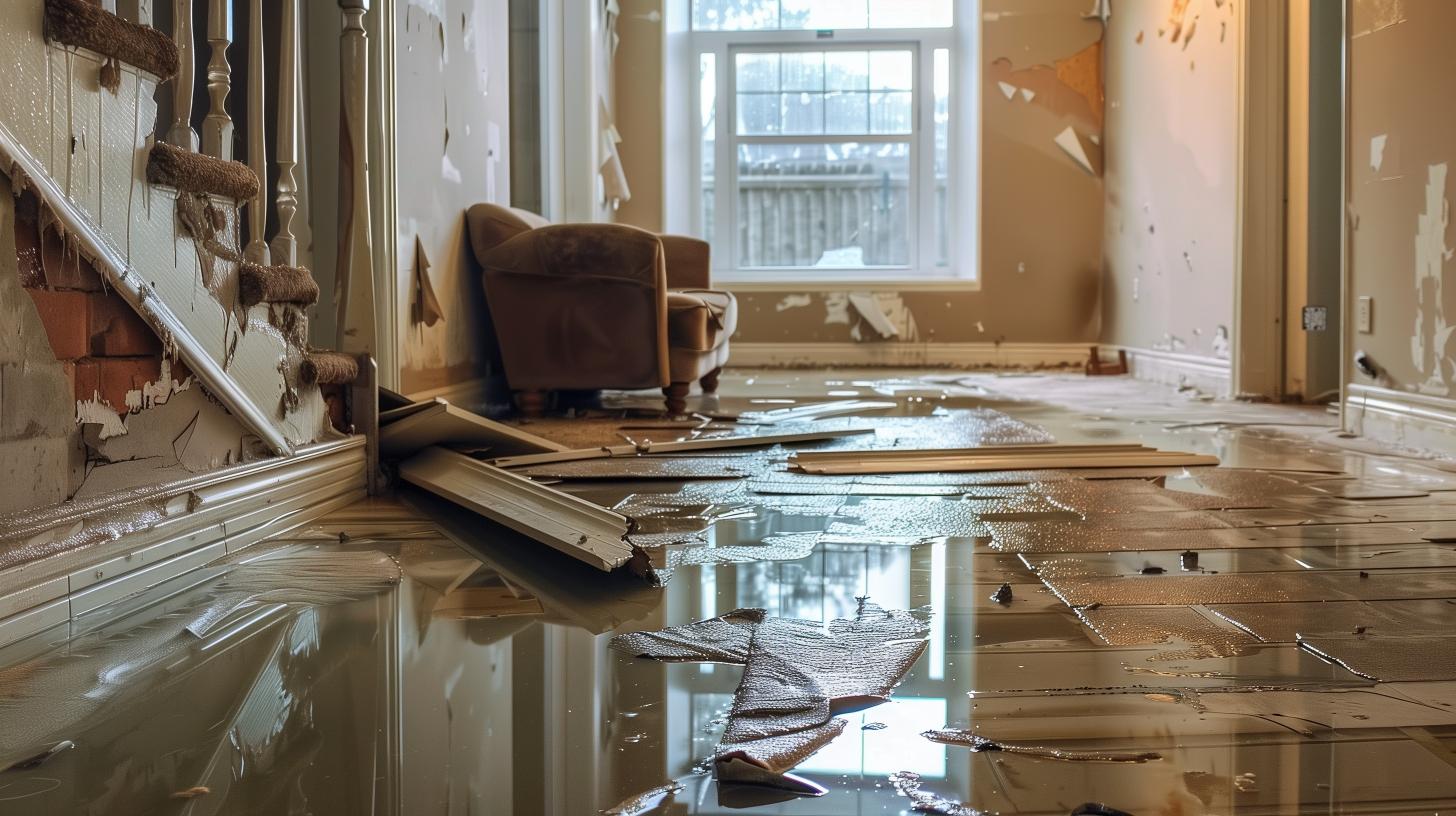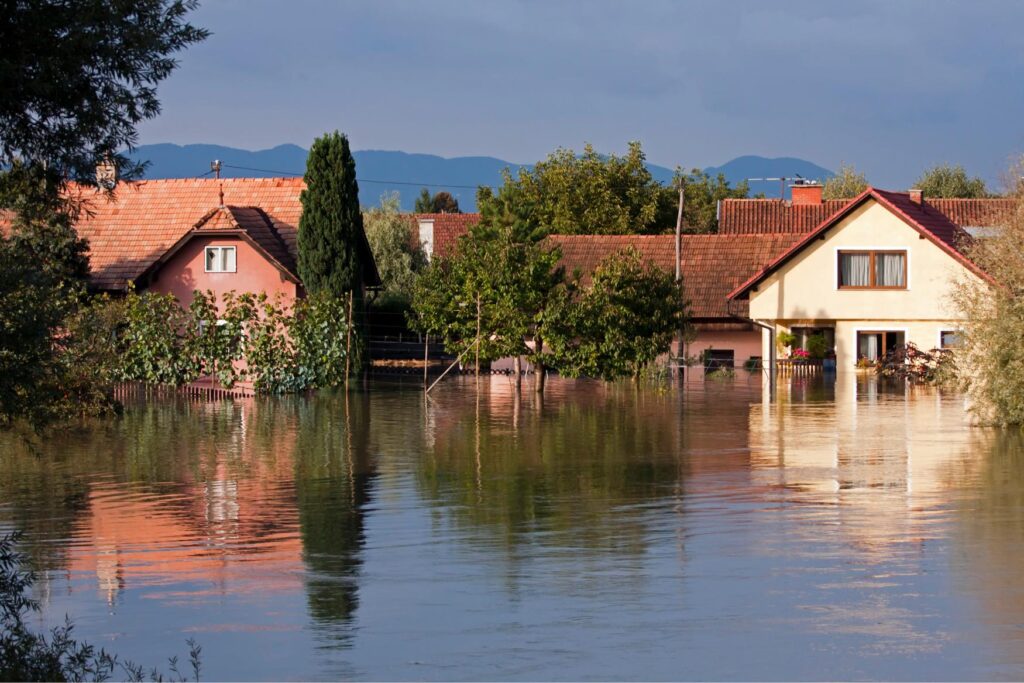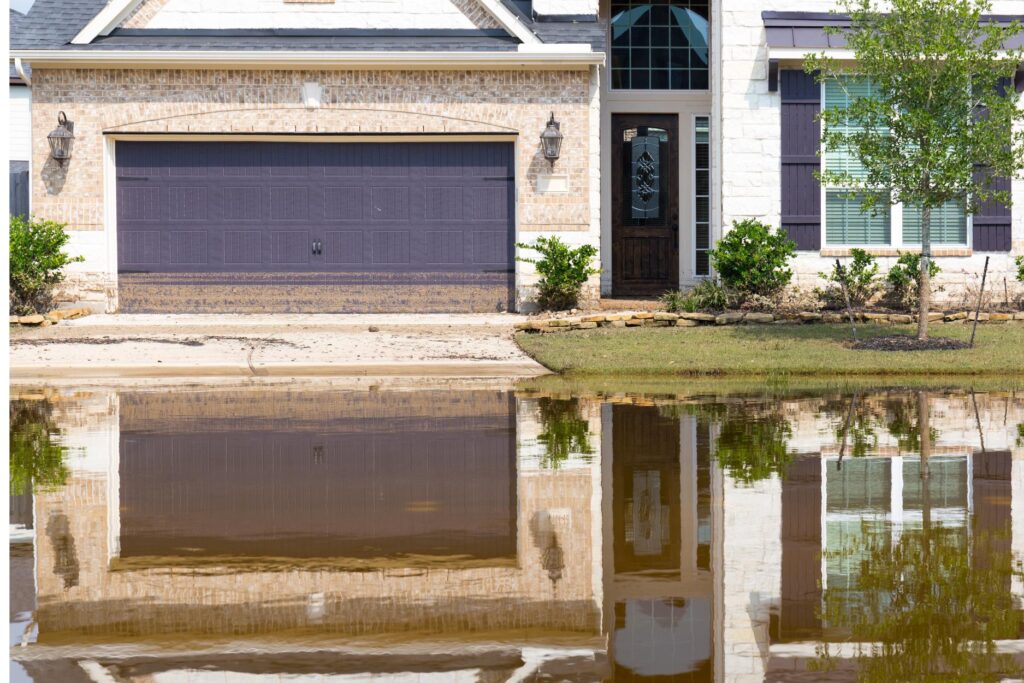Contents
Imagine a dripping faucet left unattended in a commercial building, slowly causing water to seep into the walls. The damage remains hidden until a musty smell alerts someone to investigate further. As a property owner or manager, addressing water damage promptly can save you time and money in the long run. Understanding the intricacies of water damage management in commercial buildings is crucial for protecting your investment and ensuring business continuity. By following expert advice on early detection, assessment, and containment, you can navigate through potential water damage challenges with confidence and efficiency.
Key Takeaways
- Conduct a thorough damage assessment to identify all affected areas.
- Swiftly address water sources to prevent further damage.
- Utilize professional restoration services for efficient and tailored solutions.
- Implement strategic equipment placement for optimal drying.
- Monitor humidity levels to track progress and prevent mold growth.
Identifying Water Damage Signs
To identify water damage signs in commercial buildings, start by visually inspecting ceilings, walls, and floors for any discoloration, stains, or warping. Early detection is key to preventing extensive damage. Hidden leaks can often be the source of water damage, making thorough inspection vital.
Ceilings may show signs of water damage through discoloration or sagging areas. Look for any water stains, as these can indicate a leak from above. Walls can exhibit bubbling, peeling paint, or visible water streaks. Flooring may warp or buckle due to water exposure. Pay close attention to any musty odors, as they could point to mold growth resulting from excess moisture.
To uncover hidden leaks, consider using specialized inspection methods such as thermal imaging or moisture meters. These tools can help identify moisture sources behind walls or ceilings that aren’t immediately visible. Regularly checking areas prone to water damage, like around plumbing fixtures or near windows, can aid in early leak detection.
Implementing prevention strategies, such as maintaining proper ventilation and promptly addressing any plumbing issues, can significantly reduce the risk of water damage. By staying vigilant and conducting routine inspections, you can safeguard your commercial building against the costly consequences of water damage.
Assessing Damage Extent
When assessing the extent of water damage in commercial buildings, thoroughly examine the affected areas for visible signs of deterioration and moisture infiltration. Start by identifying the water source to understand the root cause of the damage. Is it from a burst pipe, a leaky roof, or flooding? Determining the water source is crucial as it impacts the type and severity of the damage.
Conduct a detailed damage assessment to evaluate the full scope of the affected areas. Look for discoloration, peeling paint, sagging ceilings, and warped flooring. These are indicators of water damage that require immediate attention. Assess how far the water has traveled and the extent of any structural damage.
Understanding the property impact is essential for devising a restoration timeline. Consider how the water damage has affected the functionality of the space. Are there areas that are no longer safe for use? How has the damage impacted daily operations? These insights will help prioritize areas for restoration and ensure a swift recovery process.
Documenting Damage for Claims
Properly documenting the water damage in commercial buildings is crucial for facilitating insurance claims and ensuring a smooth restoration process. When dealing with water damage, it’s essential to understand the ins and outs of your insurance coverage. Review your policy to grasp the extent of your coverage, including what’s and isn’t included in your plan. This knowledge will guide you in documenting the damage effectively to maximize your insurance claim.
Begin by thoroughly collecting evidence of the water damage. Take detailed photographs and videos from multiple angles to provide a comprehensive view of the affected areas. Make sure to capture close-up shots of any visible damage to walls, floors, ceilings, and equipment. Additionally, keep a written record detailing the date the damage occurred, the source of the water intrusion, and any immediate actions taken to mitigate the harm.
Organize all your documentation in a secure and easily accessible location. This will streamline the insurance claim process and help expedite the restoration of your commercial building.
Containing Water Intrusion
You need to promptly address water intrusion to avoid costly damage.
Utilize leak detection methods to pinpoint the source of the water entry accurately.
Implement structural drying techniques to prevent further harm and mold growth within the commercial building.
Leak Detection Methods
Utilize advanced technology such as thermal imaging cameras to effectively identify and locate leaks within commercial buildings, enabling prompt containment of water intrusion. Leak detection technology plays a crucial role in preventing extensive water damage by allowing early detection of leaks before they escalate. Early warning systems combined with moisture detection tools offer a proactive approach to managing potential water intrusion issues before they become significant problems.
| Leak Detection Methods | Description | Benefits |
|---|---|---|
| Thermal Imaging Cameras | Utilizes infrared technology to detect temperature changes and pinpoint sources of water leaks. | Allows for non-invasive leak detection, enabling quick identification and mitigation. |
| Moisture Meters | Measures the moisture content in various building materials to identify areas prone to water intrusion. | Helps in identifying hidden leaks and moisture buildup, preventing structural damage. |
| Acoustic Leak Detectors | Detects leaks by analyzing sound frequencies produced by water escaping from pipes or fixtures. | Enables precise location of leaks without causing disruption to the building structure. |
Structural Drying Techniques
To effectively contain water intrusion in commercial buildings, employing specialized structural drying techniques is imperative. Moisture control plays a crucial role in preventing further damage to the building’s structure.
After extracting standing water, the next step involves utilizing high-powered air movers and dehumidifiers strategically placed to facilitate rapid drying. These equipment help in evaporating moisture trapped in building materials like drywall, flooring, and ceilings.
Additionally, utilizing ventilation systems aids in circulating dry air throughout the affected areas, expediting the drying process.
Properly monitoring humidity levels is essential during structural drying to ensure that all moisture is effectively removed, preventing potential mold growth. It’s also crucial to inspect hidden spaces like wall cavities and under flooring to address any residual moisture.
Implementing these structural drying techniques meticulously can help mitigate long-term water damage consequences, preserving the integrity of the commercial building. Remember, swift and thorough drying is key to preventing costly repairs and ensuring a safe indoor environment for occupants.
Preventing Mold Growth
Efficiently preventing mold growth in commercial buildings necessitates swift containment of water intrusion to inhibit the ideal conditions for mold proliferation. Moisture control is paramount in this endeavor. Ensure that any leaks or water damage are promptly repaired to prevent lingering dampness, as mold thrives in moist environments. Regularly inspecting plumbing fixtures, roofs, and windows for any signs of leaks can aid in the early detection and prevention of water intrusion issues.
Moreover, maintaining proper ventilation systems is crucial for reducing humidity levels within the building. Well-functioning ventilation helps to circulate air effectively, preventing moisture buildup and mold formation. Consider installing dehumidifiers in areas prone to high humidity to further control moisture levels and inhibit mold growth.
Drying and Dehumidifying Process
Start by setting up industrial-grade dehumidifiers and high-powered air movers to effectively dry out the water-damaged areas in the commercial building. These essential pieces of equipment play a crucial role in accelerating the drying process, reducing humidity levels, and preventing further damage. Regular equipment maintenance is key to ensuring optimal performance and efficiency during the restoration process. By monitoring humidity levels closely, you can control the environment to facilitate quicker drying times.
When considering the restoration timeline, it’s vital to act promptly to mitigate potential structural issues and mold growth. The longer water sits, the higher the likelihood of extensive damage, leading to increased costs and longer restoration periods.
Cost considerations should also include the energy consumption of running dehumidifiers and air movers continuously. However, the investment in proper drying equipment is a crucial step in preventing secondary damages and ensuring a thorough restoration.
Efficiently drying and dehumidifying the affected areas requires a strategic placement of equipment to target all damp spaces effectively. Ensure proper ventilation to aid in the evaporation process and remove moisture from the air. By following these steps diligently and monitoring progress consistently, you can expedite the drying process, minimize costs, and restore the commercial building promptly.
Salvaging Property Contents
Utilize protective gear and appropriate tools to salvage property contents effectively in water-damaged commercial buildings. Begin by conducting a thorough inventory assessment to determine the extent of the damage and prioritize salvage efforts. This initial step helps in identifying valuable items that require immediate attention and those that may need specialized restoration techniques.
When salvaging property contents, it’s crucial to follow proper salvage techniques to maximize the chances of successful restoration. Start by removing items from the affected area to a dry, well-ventilated space. Use dehumidifiers and air movers to expedite the drying process and prevent further damage. Sort through the items, separating salvageable possessions from those beyond repair. Employ cleaning methods such as wiping down surfaces, disinfecting, and deodorizing to restore items to their pre-damaged state.
During the salvage process, prioritize items based on their value, sentimental significance, or criticality to business operations. Utilize appropriate packing materials to transport salvaged items safely to restoration facilities if necessary.
Remember to document the salvage process thoroughly for insurance purposes, including photographs, detailed lists of salvageable items, and restoration efforts undertaken.
Addressing Mold Growth
You should focus on implementing effective mold prevention strategies to safeguard your commercial property. By promptly addressing water damage issues, you can prevent mold growth before it becomes a major problem.
Utilize professional mold removal techniques to ensure a safe and healthy environment for your occupants.
Mold Prevention Strategies
To effectively address mold growth in commercial buildings, implementing proactive and thorough mold prevention strategies is essential. Begin by conducting regular mold inspections to identify any signs of mold early on. Inspections should focus on areas prone to moisture accumulation such as basements, attics, and around plumbing fixtures.
Addressing moisture control is paramount in mold prevention. Ensure proper ventilation in areas like restrooms and kitchens to reduce humidity levels. Fix any leaks promptly, as even minor water intrusions can lead to mold growth. Implement a routine cleaning schedule, using mold inhibitors on surfaces that are susceptible to mold.
Consider installing dehumidifiers in areas with high humidity to maintain optimal moisture levels. Educate employees on the importance of reporting any water damage or leaks immediately to prevent mold from spreading. By being vigilant with mold inspections and moisture control measures, you can significantly reduce the risk of mold growth in your commercial building.
Mold Removal Techniques
When addressing mold growth in commercial buildings, it’s imperative to employ effective mold removal techniques to eradicate the existing mold and prevent further spread. Mold prevention and remediation techniques are crucial to ensure a safe and healthy environment for occupants.
Begin by identifying the source of moisture that led to the mold growth and fix it to prevent future issues. Next, isolate the affected area to prevent the spread of mold spores to other parts of the building. Utilize proper ventilation and protective gear such as masks and gloves when removing mold to avoid exposure.
For small areas of mold growth, scrubbing with detergent and water can be effective. However, larger infestations may require professional help to ensure thorough removal. HEPA vacuums and air scrubbers can help in capturing mold spores during the cleanup process.
Once the mold is removed, it’s essential to address the underlying moisture issue to prevent regrowth. Regular inspections and maintenance can help in the early detection and prevention of mold in commercial buildings.
Repairing Structural Damage
Repairing structural damage in commercial buildings requires meticulous assessment and swift action to ensure the safety and integrity of the property. When dealing with water damage, emergency repairs are crucial to prevent further deterioration.
Conduct a thorough inspection to identify all affected areas, including walls, ceilings, and support structures. Implementing a temporary fix, such as shoring up compromised sections, can help stabilize the building while you work on long-term solutions.
Once emergency repairs are in place, it’s time to develop detailed reconstruction plans. This involves creating a step-by-step strategy to address the structural damage efficiently. Consider engaging experienced contractors or structural engineers to assist in this process. They can provide valuable insights and ensure that the repairs meet safety standards and building codes.
When planning the reconstruction, prioritize the structural integrity of the building. Focus on repairing or replacing damaged load-bearing elements to prevent any further risks. Additionally, address any underlying issues that may have contributed to the water damage, such as faulty plumbing or inadequate drainage systems.
Implementing Preventive Measures
Consider incorporating proactive maintenance strategies to prevent water damage in commercial buildings. Regular inspections and timely repairs of potential vulnerabilities are essential. Establish structured maintenance schedules for routine checks on drainage systems. This can help identify any blockages or leaks that may lead to water damage.
Ensuring that roof inspections are conducted periodically is crucial. This helps in detecting any signs of damage or deterioration that could result in leaks during heavy rainfall or snow. Pay close attention to plumbing fixtures, such as pipes, faucets, and toilets. This can help prevent water leaks and bursts that may cause significant damage if left unchecked.
Hiring Professional Restoration Services
When facing water damage in a commercial building, hiring professional restoration services is crucial. These experts provide a comprehensive restoration process overview, ensuring that all steps are efficiently executed.
The benefits of their expertise include faster restoration times and a thorough, professional approach to minimizing damage.
Restoration Process Overview
If you are faced with water damage in your commercial building, the restoration process necessitates the hiring of professional restoration services for an efficient and effective recovery. When engaging these services, the first crucial step is the thorough damage assessment they conduct to determine the extent of the water damage. This assessment helps in creating a precise restoration timeline that outlines the steps needed to restore your commercial space promptly.
| Restoration Process Overview | ||
|---|---|---|
| Step 1: Damage Assessment | Step 2: Cleanup | Step 3: Drying |
| Step 4: Restoration Planning | Step 5: Repairs | Step 6: Monitoring |
Benefits of Expertise
Professional restoration services bring a wealth of specialized knowledge and skills to efficiently manage water damage in commercial buildings. When facing water damage, enlisting expert guidance is crucial. These professionals possess industry knowledge that allows them to assess the extent of the damage accurately and determine the most effective restoration plan tailored to your specific situation.
By hiring professional restoration services, you benefit from their expertise in handling water damage efficiently. They have the necessary tools and equipment to address the issue promptly, preventing further damage and mold growth. Moreover, their experience enables them to identify hidden sources of water damage that untrained eyes might overlook.
With professional restoration services, you can rest assured that the restoration process will be conducted following industry best practices. Their attention to detail and thorough approach ensures that your commercial building is restored to its pre-damaged condition swiftly and effectively. Trusting experts in water damage restoration can save you time, money, and unnecessary stress in the long run.
Summary
As you take the necessary steps to manage water damage in your commercial building, remember that prevention is key. By staying vigilant and addressing water intrusion promptly, you can avoid costly repairs and extensive damage.
Keep an eye out for signs of water damage, document any issues for insurance purposes, and enlist the help of professional restoration services when needed.
With proactive measures in place, you can ensure the longevity and integrity of your commercial property.




